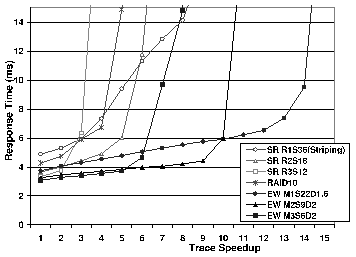


Next: Effect of Double Synchronous
Up: Experimental Results
Previous: Playing the Trace at
Playing the Trace at Accelerated Rates
Figure 11:
Comparison of TPC-C throughput^M
on alternative disk array configurations as we vary the I/O rate. The^M
total number of disks is a constant (36). The size of the delayed^M
write buffer is 10,000 blocks.
 |
We play the TPC-C trace at accelerated rates in the experiments
reflected in Figure 11. It compares I/O response
times of various array configurations as we maintain a constant total
of 36 disks for each configuration. (Note that the
 SR-Array configuration is simply a conventional 36-way
stripe.) In these experiments, we perform replica propagation in the
background. (A maximum of 10,000 blocks can be buffered on an array
for background propagation.)
The EW-Array has the best response time under all arrival rates and it
generally delivers much higher sustainable throughput than
conventional configurations. For example, the maximum sustainable
throughput rates (expressed in terms of the speedup rate over the
original trace speed) on a 36-way stripe, a RAID-10, a
SR-Array configuration is simply a conventional 36-way
stripe.) In these experiments, we perform replica propagation in the
background. (A maximum of 10,000 blocks can be buffered on an array
for background propagation.)
The EW-Array has the best response time under all arrival rates and it
generally delivers much higher sustainable throughput than
conventional configurations. For example, the maximum sustainable
throughput rates (expressed in terms of the speedup rate over the
original trace speed) on a 36-way stripe, a RAID-10, a
 EW-Array, and a
EW-Array, and a
 EW-Array are
approximately
EW-Array are
approximately  ,
,  ,
,  , and
, and  ,
respectively.
As we raise the request arrival rate, idle time becomes more scarce
and the replica propagation cost becomes felt by all configurations.
We must successively reduce the degree of replication for both the
SR-Array and the EW-Array. Thanks to the very low write latency of
the EW-Array, however, the replica propagation burden on the EW-Array
represents a much lighter load. The
,
respectively.
As we raise the request arrival rate, idle time becomes more scarce
and the replica propagation cost becomes felt by all configurations.
We must successively reduce the degree of replication for both the
SR-Array and the EW-Array. Thanks to the very low write latency of
the EW-Array, however, the replica propagation burden on the EW-Array
represents a much lighter load. The
 EW-Array
remains a configuration of choice that offers sub-5 m
EW-Array
remains a configuration of choice that offers sub-5 m response
times for an arrival rate that is as high as
response
times for an arrival rate that is as high as  the original,
a rate that has rendered replica propagation a costly luxury that the
other approaches cannot afford. The payoff of replication is better
read response time than that on the other configurations.
In addition to eager-writing,
two other factors contribute to the EW-Array's superior
throughput. One is the greater flexibility afforded by its SATF-EW
local disk scheduler. The other is the better load-balancing
opportunities afforded by the array-wide scheduling heuristics as
writes are scheduled to disks with shorter queues and reads are
serviced by choosing among multiple candidate copies on different
disks.
the original,
a rate that has rendered replica propagation a costly luxury that the
other approaches cannot afford. The payoff of replication is better
read response time than that on the other configurations.
In addition to eager-writing,
two other factors contribute to the EW-Array's superior
throughput. One is the greater flexibility afforded by its SATF-EW
local disk scheduler. The other is the better load-balancing
opportunities afforded by the array-wide scheduling heuristics as
writes are scheduled to disks with shorter queues and reads are
serviced by choosing among multiple candidate copies on different
disks.



Next: Effect of Double Synchronous
Up: Experimental Results
Previous: Playing the Trace at
Chi Zhang
2001-11-16

